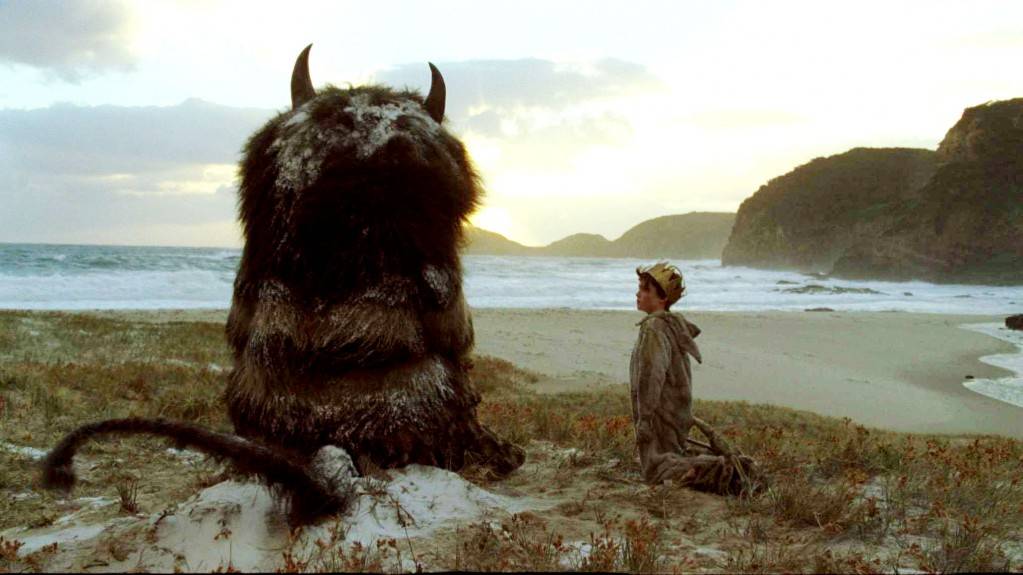
Where the Wild Things Are movie review
– by Rachel Fox
“A-gain. A-gain. A-gain,” my delightfully impish niece would plead after each reading of Maurice Sendak’s literary classic, Where the Wild Things Are.
Being prone to over-indulgence myself, I would (again) don the voices and actions that have since become my Wild Things trademark. You can tell a lot about a grown-up based on how they tell this story to a child. (As it so happens, I give a great Wild Rumpus.) Relishing this fleeting moment between us; a precious tender space somewhere between the warm safety of a cuddly snuggle and the relative unknown of lights-out and dreams and monsters in the closet.
Of course, I would indulge her. Until, that is, I hear the opening strains of 30 Rock coming from the next room. Childhood is inherently unfair.
To say that director Spike Jonze’s telling of this beloved tale is burdened by expectation and anticipation is an understatement. The all-ages crowd at last night’s Where the Wild Things Are screening demonstrated a palpable level of excitement generally reserved for revivalist second-comings. We all know the story, but the curiosity factor is nonetheless high. How would Jonze spin this short story into a feature film? What would the Wild Things look like? Could we pretty-pretty-please return to that magical land of childhood past?
The original material provides but a skeleton for a story – the book itself comprises roughly a paragraph. Jonze does a remarkable job of humanizing our Max (portrayed by the disarmingly emotive, heartbreakingly raw Max Records) and setting up the world in which he lives. The slings and arrows of childhood are deftly displayed here, so much so that at one point I felt startled, uncomfortable, and self-aware when watching one of my own personal abandonment-issue nightmares played out onscreen.
Max’s emotional turmoil is entirely relatable, mirroring the confusion and frustration we all felt at that pivotal point in childhood when we discover that we are no longer the sole focus of those around us. His uncontrolled emotions result in wildly aggressive and misunderstood behavior that is met with less tolerance and more consequence from those around him. The genesis of childhood angst may be located at the point at which this shift occurs – externally, and ultimately, internally. We are then left to spend the rest of our lives pondering the unique series of events that shape us; we’ve all been there, we’ve all felt like Max. Perhaps some of us still do.
In the land of the Wild Things, Max is crowned King; over the course of the film he comes to understand not only why he isn’t, but why he can’t be. As children, we are all Kings and Queens, the veritable rulers of those around us, our inner Wild Things both tolerated and indulged. Max’s adventures living among the Wild Things provides the perfect backdrop for childish awkwardness, a safe and forgiving place to reflect upon how his actions affect others and the responsibility of that emotional reality. His understanding deepens beyond the innocence permitted by childish naiveté, like the difference between apologizing because your mother has ordered you to versus feeling sincere regret for your actions. Max makes the choice to return home and though it is bittersweet, it is entirely necessary.
One can’t deny the visual delight of the Wild Things themselves. Detailed and real, these otherworldly creatures seem to inhabit a universe I can actually relate to (my CGI-related suspension-of-disbelief issues are too weird and numerous to mention here), mostly having to do with the fact that puppets respond to gravity in much the same way I do.
Outlandish yet adorable, I found the Wild Things to be entirely engaging despite their ugliness – unlike, say, the puppets in The Dark Crystal (whose disproportionate features and overall creepiness may not have been in the same league as the Twilight Zone’s grotesque Pig-Faced People, but was pretty close) – these Wild Things had much more in common with the fantasy creatures of The Neverending Story.
Wild Things KW (voiced by Lauren Ambrose) and Judith (Catherine O’Hara) have noses, tongues and mannerisms reminiscent of Falcor the Luck Dragon, while Ira (Forest Whttaker) possessed a touching wisdom and deliberate delivery that seems a clear homage to that film’s Rock Biter (“They look like good strong hands, don’t they?”).
As Christopher Robin had Winnie the Pooh, Max has Carol (James Gandolfini) as sidekick and alter-ego, the best friend, confidante and playmate required for personal growth but who must ultimately be abandoned in the dreamy land of childhood memory. A place you can go back to visit, but can never fully inhabit again once outgrown.
Where the Wild Things Are is more a thoughtful rumination on childhood and less a warm, fuzzy retelling of a children’s classic. Although there’s no doubt that children will marvel at the beasts onscreen, I have a feeling that the deeper and more melancholic tones will be lost on those who have yet to fully experience or process their childhood and that murky space between fantasy and the many textured banalities of real life. I, unlike my niece and her regular visits with the book, do not feel a need to see this film again anytime soon. I spend far too much time re-visiting my own childhood with all-too-frequent regularity.


2 responses to “Where the Wild Things Are”